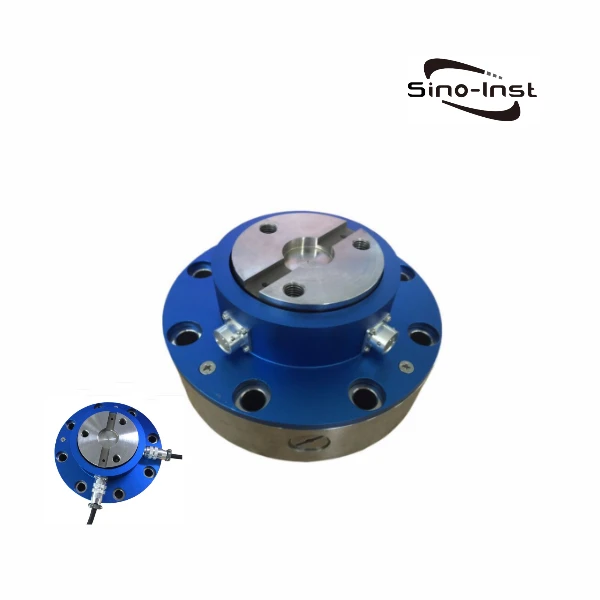
2150 Dual Range Static Torque Sensor is also known as large and small range torque transducer. It can measure both large and small dual range static torques. One end has a key flange connection and the other end has a flange connection. It is suitable for the measurement of both large and small static torques. Dual range static torque transducers are also known as motor torque transducers, mechanical torque transducers, torque testers torque transducers.
Features of 2150 Dual Range Static Torque Sensor
- The resistance strain is an integrated product composed of sensitive components and integrated circuits, with high precision and stable performance
- Measuring range: 0-20-5000N.m optional
- Torque can be measured in both positive and negative directions
- Keyed flange connection at one end and flange connection at one end
- Suitable for measurement of large and small dual-range static torque
Technical Parameters
| Parameters | Technical indicators |
| Range | 0-20,100,1000,5000Nm |
| Sensitivity | 1.5±10% mV / V |
| Zero output | ±2% F.S. |
| Non-linearity | ±0.1,0.3% F.S. |
| Hysteresis | ≤±0.05% F.S. |
| Repeatability | ≤±0.05% F.S |
| Creep | ≤±0.03% F.S/30min |
| Temperature sensitivity drift | 0.03% F.S. / 10℃ |
| Zero Temperature Drift | 0.03% F.S. / 10℃ |
| Input Resistance | 750±10Ω |
| Input resistance | 700±5Ω |
| Insulation resistance | ≥5000MΩ/ 100VDC |
| Excitation Voltage | 10-15VDC |
| Temperature Compensation Range | -10 ~ 60℃ |
| Operating Temperature Range | -20 ~ 65℃ |
| Safe Overload | 150% F.S. |
| Limit Overload | 200% F.S. |
| Cable Size | Ø5.2×3m |
| Electrical Connection | Red/E+, Black/E-, Green/S+, White/S- |
| Material | Stainless steel or alloy steel |
Dimensions
| Model | Small range Nm | Large range Nm | φA | φD | φE | φF | φG | B | C | P | φR | φH | φN1 | φN2 | T | M |
| 2150 | 20 | 500 | 158 | 98 | 78 | 27 | 120 | 74 | 40 | 3 | 60 | 138 | 8-φ11 | 8-φ17 | 10 | 3-M10 Deep 18 |
| 2151 | 30 | 1000 | 158 | 98 | 78 | 27 | 120 | 74 | 40 | 3 | 60 | 138 | 8-φ11 | 8-φ17 | 10 | 3-M10 Deep 18 |
| 2152 | 100 | 3000 | 195 | 108 | 89 | 37 | 142 | 100 | 52 | 3 | 70 | 165 | 8-φ17 | 8-φ25 | 16 | 6-M10 Deep 18 |
| 2153 | 150 | 4000 | 195 | 108 | 89 | 37 | 142 | 100 | 52 | 3 | 70 | 165 | 8-φ17 | 8-φ25 | 16 | 6-M10 Deep 18 |
Learn More About 2150 Dual Range Static Torque Sensor | Flange to Flange
If you cannot find an answer to your question in our 2150 Dual Range Static Torque Sensor | Flange to Flange, you can always contact us and we will be with you shortly.
More Featured Torque Sensors For Sale
Sino-Inst is a manufacturer of 2150 Dual Range Static Torque Sensor | Flange to Flange. We offer more than 5 types of Dual Range Static Torque Sensor.
The dual-range static torque sensor is also called the large and small range torque sensor, which can measure the large and small dual-range static torque at the same time.
Static Torque Sensor is also called reaction torque sensor, torque transducer. Mainly used for torque measurement in Static situations. Static Torque Sensor with key shaft connection at both end; suitable for static torque measurement.
Sino-Inst’s Dual Range Static Torque Sensors, made in China, have good quality, with better prices. Our Dual Range Static Torque Sensors are widely used in China, India, Pakistan, USA and other countries.
Sino-Inst’s entire team is well trained, so we can ensure that each customer’s needs are met. If you need any help with your product requirements, whether it is a Dual Range Static Torque Sensor, level sensors, or other equipment, please give us a call.
Request a Quote
Wu Peng, born in 1980, is a highly respected and accomplished male engineer with extensive experience in the field of automation. With over 20 years of industry experience, Wu has made significant contributions to both academia and engineering projects.
Throughout his career, Wu Peng has participated in numerous national and international engineering projects. Some of his most notable projects include the development of an intelligent control system for oil refineries, the design of a cutting-edge distributed control system for petrochemical plants, and the optimization of control algorithms for natural gas pipelines.
2150 Dual Range Static Torque Sensor | Flange to Flange
2150 Dual Range Static Torque Sensor is also known as large and small range torque transducer. It can measure both large and small dual range static torques. One end has a key flange connection and the other end has a flange connection. It is suitable for the measurement of both large and small static torques. Dual range static torque transducers are also known as motor torque transducers, mechanical torque transducers, torque testers torque transducers.
Product SKU: 2150 Dual Range Static Torque Sensor | Flange to Flange
Product Brand: Sino-Inst
Product Currency: USD
Product Price: 170
Price Valid Until: 2029-09-09
Product In-Stock: InStock
5